
 | |
|
Portugal Capital Area Population Languages Currency |
Lisbon (Lisboa) 92 230 km2 10 640 000 Portuguese Euro (EUR) |
Portugal is the most south-westerly country in Europe, and is entirely surrounded by Spain (to the north and east) and the Atlantic Ocean (to the south and west). The population is predominantly Catholic, despite five centuries of Muslim rule in the first millenium AD. The Portuguese were always skilled seafarers and fishermen. Their early explorers sailed all over the world, including round the Cape of Good Hope and across the Atlantic Ocean to the Americas. Fish (mainly sardines) forms a major part of the Portuguese diet. | |
If you enjoyed reading this, please send me an email. All correspondence is appreciated!
| Last updated | : | 20h14, Sunday 12 October 2025 |
| Location | : | Póvoa de Varzim, Portugal |
[Monday 29 September 2025: Cape Town, South Africa] The departure time (3:30 pm) for our flight to Luanda on TAAG (Angolan Airlines) came and went with no sign of an actual plane to get us there. Hordes of people sat in various stages of apathy at Cape Town International Aiport, staring out of the big windows at the empty space where a plane should have been, hooked up to fuel lines and a sky bridge. Other planes from other airlines took off and landed, but of our transportation there was no sign.
Eventually, at 3:45 pm (fifteen minutes after we were due to take off), a plane with unfamiliar livery landed and taxied up to the gate where we were due to board. Close up I could read "TAAG" emblazoned on the fuselage. "It'll take at least an hour to get the people off, re-fuel, load the baggage and board all this lot," I predicted to Karen. "So we're going to be more than an hour late. Probably quite a lot more."
But I'll give TAAG their due - they managed to disembark everybody from the plane and get it ready to fly back out again in only 45 minutes. In the end we took off at 4:30 pm. And, even more amazingly, we landed at Luanda ten minutes early! The pilot must have hit the throttle hard, or we had a heavy tail-wind, or both.
[Monday 29 September: Luanda, Angola] Luanda Airport at 8 pm proved to be small, cramped and mostly deserted. Most of the shops were closed. Despite the fact that we were in transit and did not need to go through Immigration or Customs, we still had to endure a mandatory (and tedious) X-ray security check. The number of passengers queueing for this procedure far outnumbered the desultory few people entering Angola via Passport Control. Most of them seemed to be heading for Nigeria - a flight to Lagos was announced shortly after we arrived, and I overheard several passengers talking about Nigeria. We found a pleasant corner and whiled away the four-hour layover until our flight to Lisbon was announced.
[Tuesday 30 September: Lisbon] The flight from Luanda to Lisbon landed fifteen minutes early, but whatever gains we made in the air we lost in the endless queue at Passport Control. We zig-zagged our way through countless loops of security tape for well over an hour and a half before finally reaching the front. The young guy at Immigration barely looked at us and waved us through without a single question. By that time the baggage at our flight's carousel had piled up and spilled over, so finding our bags entailed looking through a huge heap of unclaimed suitcases.
Luggage sorted, we headed for the airport bus station just outside the terminal buildings, where we had been reliably informed that we could get a bus direct to Porto without having to go into Lisbon. That much was true, but what all the reports we'd read had failed to mention was that you could only buy tickets for this bus online - you could not get them at any ticket counter or from the bus driver, either with cash or a credit card. Simply not possible. We tried for several minutes to buy the tickets using the airport's wifi, but it was so slow and overloaded that our phones could not even resolve the QR code we had to scan to get to the bus company's ticketing portal. With only a few minutes left before the bus departed, we debated getting a local SIM card, but often these take a few hours to be activated and we didn't have time to wait. The people at the airport Information desk were singularly unhelpful. "Take the Metro to Oriente," said a bored-looking girl. "You can buy bus tickets there." [Aside: Oriente Station is Lisbon's main transportation hub]
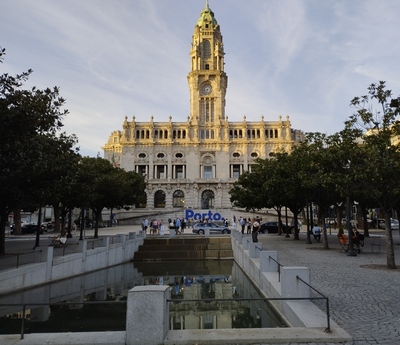
Lisbon's public transport system, like most round the world these days, uses a rechargeable tap in-tap out card. Buying the cards was simple (they only cost 50 Cents), we loaded them with 10 Euros each and within minutes we were on a train clattering through dark tunnels under the airport. Oriente Metro station, of course, was several levels beneath Oriente Train station, so we had to climb numerous flights of stairs before finding ourselves in a crazy mish-mash of concrete arches, pillars, stairwells and coffee kiosks. There was no signage. Was this the train station? It had to be. Eventually we saw a tiny TV screen listing train departure times and platforms. The next train to Porto was at 10:09. I looked at my watch; it was 10:06. With three minutes to get the train we searched in desperation for the ticket office, but that took ages because it was cunningly hidden in a corner ... and there were several people ahead of us in the queue. Plan A was already unravelling. I knew the next train had to be some time later because Porto did not appear again on the list of departures.
By the time we'd bought the tickets it was 10:20 and we had more than an hour to wait until the next train at 11:39. My head was splitting. "Time for coffee," I announced. Karen was also close to the end of her tether and agreed without hesitation. A typical Portuguese bakery in the station concourse, manned by an unshaven but cheerful barista, served us delicious Pasteis de Nata and espresso, and we started to feel a little better.
[Tuesday 30 September: Porto] The 11:39 Inter-City Express (ICE) from Lisbon terminated at Porto's Campanha station. Campanha is some distance from the centre of Porto, but that was no problem because we simply hopped onto a local train to São Bento station, right in the heart of old town. São Bento is the original station in Porto and dates back to 1904, and we spent a few minutes admiring the old murals on the walls of the concourse. From there it was a five-minute walk on narrow, cobbled streets to Nice Way Hostel, our digs for the next two nights.
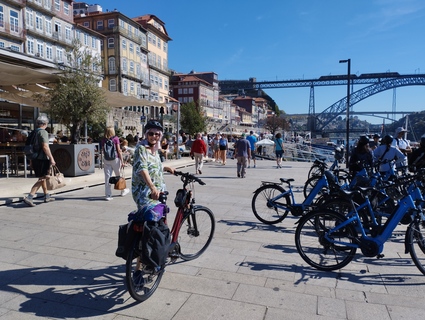
The connectivity issue was clearly going to become a big problem, so our first order of business after settling in was to find a Vodafone shop and set up Karen's phone with a Portuguese SIM card. Turns out Vodafone had an amazing special running - 95 Gigabytes of data and 1000 minutes of local (not international) calls for only 15 Euros! We took the deal without hesitation. After that we were too tired to look for restaurant deals and simply ate in the Middle Eastern joint two doors down from our hostel - the somewhat optimistically named Food Heaven. But the young Arabs who served us were friendly and their falafels with chips and salad were delicious. Even though it was a Halaal/Muslim joint, they sold all manner of hard liquor there. Strange, but we've noticed that alcohol is freely available without restriction from virtually any store.
[Wednesday 1 October: Porto] The mandatory visit to Porto's cathedral was followed by a stroll down the steep streets of Porto's old town to the Douro River. We were due to collect our rented bicycles from a place called Vieguini next to the river, and they were easy to find. We spent the rest of the day testing the bikes along the riverfront cycle path before heading back to Nice Way Hostel.
[Thursday 2 October: Vila do Conde] The chaos of packing our gear into the panniers of our bicycles occupied us in the morning, after which we checked out and headed down to the river again. Cycling downhill was a breeze; if only the entire Camino would be this easy. Even so, riding out of Porto was simple, first west along the edge of the Douro River, then north next to the sea. A delicious coffee stop at a bakery along the way was memorable in part because of the offensively gross conversation of three girls at the table next to ours. One of them was South African, and after listening to her liberal use of swear words and course descriptions we were reluctant to admit that we were also from South Africa.
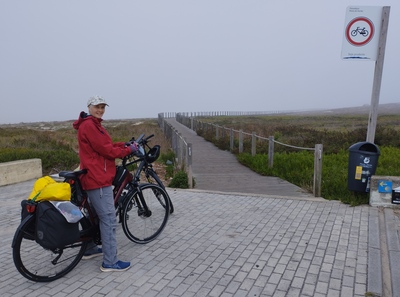
The dedicated cycle path continued for miles north of Porto. Quite often the cycle path was next to wooden boardwalks which were full of pilgrims walking the camino. Cyclists are not allowed on the boardwalks, so we frequesntly had to cycle a fair bit further than the hikers. But it was flat, the weather was superb so it was very easy. Eventually the cycle path ended and we were forced to cut inland. That was when things got a little more difficult - a confusing mish-mash of roads, intersections and small towns caused us all manner of problems. Google Maps never seemed to have the whole picture, the road signs (when there were any) did not help much and our paper maps weren't in enough detail. But finally we got back onto the Camino route in the town of Pindelo, which we discovered when we almost simultaneously saw the familiar Camino sign and a group of pilgrims ahead of us. A loaf of crusty Portuguese bread and cheese bought at a tiny neighbourhood store in a nameless small town proved to be a magnificent lunch, which we enjoyed in a forest clearing just off the cobbled road leading out of the town. We reached the major town of Vila do Conde at 4:45 pm, where we found a fabulous room for the night at the Naval Guest House.
[Friday 3 October: Apulia] The town of Vila do Conde was shrouded in thick fog when we woke. Early morning runners and dog walkers were wearing thick coats and scarves, but there was no wind and the water in the marina opposite Naval Guest House was as still as glass so we were hopeful of a fine day. In the end it was, but for most of the morning we cycled north in icy mist. There was a dedicated cycle path next to the road leading out of Vila do Conde, so the riding was easy. The sea was a stone's throw from the path, and our enjoyment was complete when we spotted a small padaria (bakery) in Povoa de Varzim that served the most delicious coffee, easily the best we've had in Portugal so far. The place had no name that I could see - it was just a small, unassuming building next to the road with a couple of tables outside. The barista was a young blond woman who spoke no English, but whose face lit up when I told her that her cafe estava delicioso.
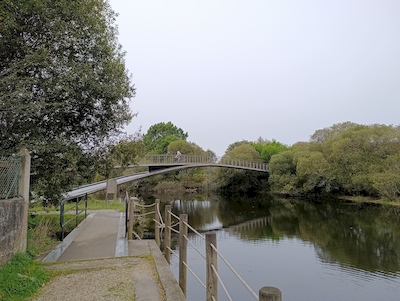
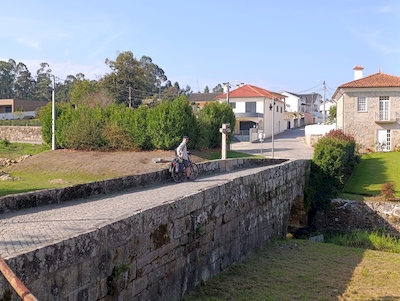
Eventually the main road next to the sea cut inland, but the cycle and walking paths continued north on quiet side roads, many of them cobbled. After a while even these minor roads disappeared. The path for hikers became a boardwalk above the beach. Further south it was a rule that people were prohibited from cycling on the boardwalks, but here there were signs saying that cycling was allowed provided you seja prudente (exercised caution). And caution was necessary, because in places the boardwalks were so narrow that there was only a few centimetres of space between the handlebars and the railings. A momentary loss of balance would result in a catastrophic accident. After a while we left the boardwalks and returned to the road, which was cobbled (bad) but flat (good) and empty of traffic (even better).
We began to look for a spot for another picnic lunch, but then I saw a sign advertising Home of Pilgrims, 2.5 km. We had booked a room at this place (in the town of Apulia) and I hadn't realized we were so close to it; there was no point stopping if we only had two and a half kilometres to ride, so we just headed on and checked in at about 1:45 pm. We enjoyed our picnic lunch in the guest house common room.
[Saturday 4 October: Vila Praia de Ançora] We decided to put in a slightly longer day today, and booked a room in a guest house in Ançora Beach. According to Google Maps, the distance was just over 49 kilometres. The day was a combination of high speed cycling on long, straight downhills and agonisingly slow progress on rocky paths that were difficult to walk on, never mind wheel a bicycle. And to make matters worse it rained off and on the whole day. Not hard, but persistent drizzle, just enough to be irritating.
The route out of Apulia was on dedicated cycle paths right next to the sea for several kilometres, but then we veered inland and into the low hills to the east. There we encountered narrow back streets, mostly cobbled, that caused our speed to drop dramatically. Just when we needed it, a coffee stop appeared - a tiny neighbourhood cafe called Toquinho dos Caminhantes in the village of Belinho. It was full of elderly men sipping espresso, and (predictably), the coffee was outstanding. Several other pilgrims came in while we were there, all needing their mid-morning coffee fix.
The cobbled roads continued, then became even worse - paths that were constructed of rough stones. They surface was so uneven and bumpy that you could not cycle fast. The narrow roads twisted this way and that, but we were saved from checking Google Maps every couple of minutes because yellow Camino arrows had been painted at any intersection where a choice of directions had to be made. Drained from all the pounding and bumping over the stones and cobbles, we heaved a sigh of relief when a pilgrim arrow pointed down a sandy path through forest. We turned onto the path, revelling in the smooth surface beneath our wheels. Unfortunately the good news did not last long - the path narrowed until it was barely wide enough for us to pass through, then morphed into a downhill over rocks. And not rocks carefully placed to create a road surface, but rough and sharp rocks such as those you find on wilderness paths on mountain slopes. It was utterly impossible to ride. We had to dismount and push/pull/lift/heave our bikes over the rocks. The going was slow and exhausting. We didn't see any hikers on that section, but if we had they would have overtaken us and left us far behind.
Finally we reached the bottom of the track, which joined (you guessed it) a cobbled road. We stopped to regroup. "I can't do any more cobbles," said Karen, her face gray with fatigue. "We have to go back to the main road. Otherwise we'll be here all night."
I nodded in agreement. We checked Google Maps and rode down towards the road that was more-or-less parallel to the direction we were going. Donning our helmets at the intersection, we turned onto it. It may have been the "main road", but it was still a fairly minor route, so traffic was sparse and not very fast. Best of all, it was flat. We made up time steadily, even though the rain reappeared.
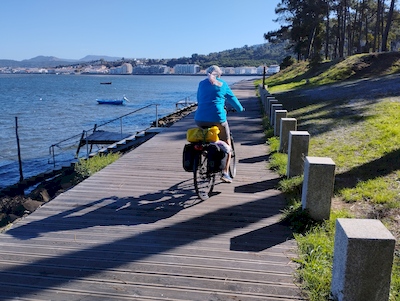
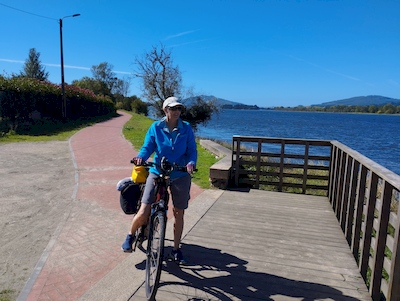
At one point we came to a long, straight section that was downhill, and where visibility was excellent for kilometres ahead of us. Karen took off and left me behind as she pedalled away in high gear, then just free-wheeled. I have never seen her cycle so fast. I was also free-wheeling, and at such a high speed that I could not turn the pedals fast enough even though I was in the highest gear my bike had. We zinged down the hill, almost keeping pace with the cars that slowly inched past, until the incline levelled off and we reached a traffic circle. The reason for the long downhill became clear - ahead of us was a broad river (the Lima River) and the large town of Viana do Castelo.
The next half an hour was a nightmare. The road joined a bridge over the river, a bridge that was barely wide enough for two cars. There was no space on the bridge for a car to overtake a bicycle if another car was approaching from the other direction. There were pedestrian paths on both sides of the bridge, but these were screened off from the road by a fence, and they were so narrow that my handlebars only just fitted between the roadside fence and the riverside barrier. Riding along these would be very difficult. Besides, there were a lot of pedestrians on the paths and it would impossible for a person to get past a bike, or vice versa. We had no choice but to ride on the bridge. I looked across; it was a long way, and there was a lot of traffic.
"Wait for a gap in the traffic then go like hell," I said to Karen. "Nothing else we can do."
I followed my own advice. As soon as I saw a relatively big space between one car and the next I pushed off from the kerb and hit the pedals hard. I geared up, gritted my teeth and pedalled at my limit. Lungs bursting, thighs screaming, I reached the other side of the bridge unscathed. A railway line also crossed the bridge (below the road; it was a double-decker bridge) and where the road came down and veered away there was an open area next to the tracks. I stopped and waited for Karen, breathing hard. She pulled in a couple of minutes later. "A car stayed behind me the whole way across," she panted. "There must have been a huge tailback. But I made it."
Viana do Castilo looked like a big, busy city. The traffic was insane, the roads were narrow and the way out was brutally steep. We struggled through hectic intersections, under bridges and round traffic circles snarled with cars. The rain came down harder. And then Karen's chain came off. It tooke five minutes of effort in the rain to coax the chain out from where it had jammed and thread it back onto the cogs. Drenched, fingers dirty we mounted up and continued on, ever upwards, until we got out of the city centre. Almost simultaneously the rain eased off, the gradient levelled out and the traffic vanished. We found our way to the N13 coast road and pedalled north.
Late in the afternoon we came to the village of Ançora. I momentarily thought we'd reached our destination, but realized that the place we'd booked into was at Ançora Beach (Vila Praia de Ançora), which was just north of Ançora itself. I wearily pedalled on. I was tired after a very long day of cycling, much of it one cobbles or stone-paved roads. But a pedestrian/cycle track shortcut to Ançora Beach appeared on the left and we took it; it was a delightful meander through parkland to Vila Praia de Ançora, where we found Baixinho Guest House in a narrow lane half a block from the beach. We checked into a very nice room with huge relief. We'd cycled over 55 kilometres and were finished.
[Sunday 5 October: Valença] The exertions of the previous day, 55 kilometres of riding (much of it on cobbled or stony roads), had taken their toll on us. So we dialed down our plan for the day and aimed for the city of Valença, merely 34 kilometres from Vila Praia do Ançora (Ançora Beach). In the end we rode much further than that because we took the path alongside the Minho River from the city of Caminha rather than the straight, direct route on the road. But it was a fantastic day - apart from one short section on the busy N13 highway and a double traffic circle that we negotiated on the wrong (left) side of the road, we spent the entire day on cycle tracks.
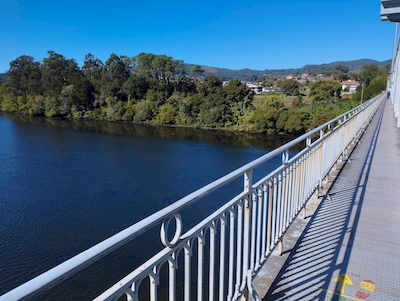
When we left Vila Praia do Ançora there was a path for pedestrians and a path for cyclists next to the sea, and both of these continued all the way to the Minho River mouth. After the drizzly rain of the previous day it was cloudless but far from hot; an icy headwind hit us from the north. We were relieved to stop at a tiny village that didn't seem to be on Google Maps, yet it hosted a surf shop and a coffee shop cleverly sited to catch the morning sun. It was full of people sipping espresso and advertised Buondi coffee, one of the two main coffee brands that we've seen in Portugal (the other is Delta, but of the two Buondi is definitely the better). The coffee was indeed delicious. And FAST - coffee places in Portugal are incredibly quick; you give your order, look away for a second and your coffee arrives. Portuguese baristas know their stuff and can churn out coffee at rate of knots I haven't seen anywhere else in the world.
The Minho River is the border between Portugal and Spain and is very wide; there is no bridge at the mouth, so to cross over to Spain you have to get a ride on one of the many private taxi boats that operate between the two countries. Very small boats too ... we hadn't planned to cross at the mouth, but if we wanted to I'm not sure that we would have been able to get our overloaded bikes onto any of the boats we saw. Instead we rode on a boardwalk up the river and skirted the city of Caminha. Heading away from the sea got us away from the cold wind and shortly afterwards we reached the town of Moledo. We spotted a padaria (bakery) up a quiet side street, bought crusty bread rolls and cheese (again) and enjoyed another great picnic lunch a little further on.
We were forced onto the busy N13 road for a few kilometres and thought that might be our lot for the rest of the day. But we had a lucky break - we stopped at a SPAR supermarket in the town of Lanhelas to buy some provisions, and while we were standing outside the store two other long-distance cyclists came past. They greeted us cheerily and we watched as they veered into the "left only" lane and rode down a minor side road a hundred metres further. They didn't hesitate, or look at maps or phones. Where did that road go? The signboard at the turn said this was the "EcoVia" (whatever that was). We decided to follow them, and found that the road went down to the river and then morphed into a paved path for pedestrians and cyclists. The path was fantastic - it was right next to the river, away from the road and lined with trees and bushes.
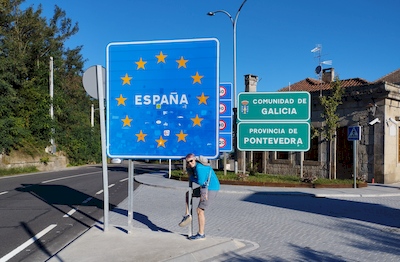
The only blip in a spectacular day of cycling was when we came to the first bridge over the river to Spain. The riverside path ended and we had to figure out a way round a confusing double traffic circle, made worse by the fact that we found ourselves on the wrong (left) side of the road. But we managed to get out alive, albeit back on the N13 highway. But shortly afterwards I saw another sign pointing to the EcoVia; we took the turn, rode through forest on rough dirt tracks next to a railway line and eventually arrived back on the paved riverside path. This time we resisted every temptation to turn off until we reached the outskirts of the city of Valença. By now it was very hot, and we toiled along sun-baked streets, past people sipping drinks in the shade at pavement cafes, and finally found the Val Flores Hotel exactly where Google Maps said it would be. Our room was fantastic, and boasted a balcony with big sliding doors and excellent views of the fortaleza, Valença's walled old town.
Supper that evening was a magnificent repast in a restaurant called Cristina's. They offered a Pilgrim's menu comprising a drink, bread and butter, vegetable soup, a main course (meat or fish), dessert and coffee. So we had one pilgrim's meal plus a salad, which cost a total of 20 Euros (very cheap for the amount of food we got). We shared everything - Karen had the drink (port, of course), dessert, most of the salad and half of the soup, and I had the coffee, most of the fish and the rest of the soup. And we both walked away replete, me in a straight line and Karen in an unsteady sort of weave because the amount of port the waiter poured for her was eye-popping.
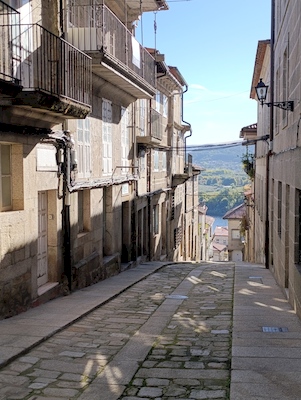
[Monday 6 October: Valença] We had reached the point where we had to decide whether to continue on to Santiago in Spain and go back to Porto (at least part of the way) by train, or turn round and cycle back to Porto via the inland Camino route. We'd rented the bicycles for 14 days and had used up five of them, so we would not have time in the nine days left to ride all the way to Santiago and back. The problem was that the inland route is much more difficult than the very flat coastal path, meaning we would cover less distance each day. Plus we'd been to Santiago back in 2018 when we'd walked from St Jean Pied-de-Port in France (see my blog of that trip), so we decided that Valença would be our turn-around point.
However, we still wanted to see the old Spanish town of Tui, just across the river from Valença. And we needed (well, wanted) a rest day, so we booked another night in the Val Flores Hotel and walked to Tui across the old double-decker concrete and iron bridge (the bridge carries trains on the top level and vehicles and pedestrians underneath). The distance between the two towns is only about three kilometres, and the whole way there and back we were among pilgrims huffing and puffing their way to Santiago. We greeted them cheerily, either with "Bom camino" (on the Portuguese side of the bridge) or "Buen camino" (on the Spanish side). However, we did feel somewhat like frauds, knowing that we were not going to Santiago at all. On the other hand it was very liberating not having bicycles, helmets and luggage to worry about. Tui proved to be charming and we enjoyed a relaxing morning there.
Unfortunately most restaurants in Portugal seem to close on Mondays. We could not find anywhere to eat in Valença that evening, and had to resort to a picnic supper in our hotel room - tinned sardines, a baguette, cream cheese, fruit and yoghurt.
[Tuesday 7 October: Rubiães] We left Valença at the leisurely hour of 9:45 am and retraced our route (in reverse) from two days before. But when we reached the riverside path we veered left (east) and rode for miles through a succession of tiny country villages. The roads meandered this way and that, never busy, past cultivated fields, pastures of goats, sheep and cows and old stone houses. The weather was balmy and it was delightful. Things got even better in the sleepy village of Sau Pedro da Torre, where we found an attractive coffee shop a stone's throw from the church in the centre of town. Two cups of great coffee and a pasteis de nata cost only 2.90 Euros! That is half the price we were paying in Porto or at some of the tourist joints along the coast. Incredibly, espresso was 80 cents (about 16 SA Rands). No way can you get an espresso for only 16 Rand in South Africa.
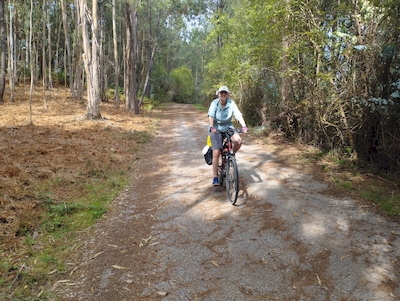
Shortly after that things became a little more difficult. We'd ridden too far west and had to veer sharply to the east to get back on track for the guest house we'd booked in the tiny village of Rubiães. Suddenly the quaint country lanes became murderous uphills. Our thighs took serious punishment then quit in protest; at one point we had to dismount and wheel our bikes up a hill that was simply too steep for us. Pushing a bicycle loaded with gear up a sharp incline is much more difficult than walking up the incline ... But eventually things levelled out, the road went under a major freeway and entered a forest. Drenched with perspiration, we stopped for a snack. The forest path continued for quite a long way, up and down, but generally level.
It was already early afternoon and we were still some way short of Rubiães. A crazy stretch of downhill brought us much closer very quickly, but it was inevitably followed by a hill that took everything out of me. At the top was a T-junction, and on the other side of the road I saw an object that was once common all over the world but which is very rare these days - a public telephone. I was shattered with exhaustion but just had to try it. And it worked! I heard a dial tone when I lifted the receiver. From there a short stretch on a stony path brought us to Casa das Lages, our rustic digs for the night.
[Wednesday 8 October: Ponte de Lima] An easier day of cycling, but very enjoyable. Once again we navigated our way through a crazy series of country lanes, many only wide enough for one car. A lot of the time we were on the official Camino path, so we encountered many pilgrims walking towards us. It was also very hot; we sweated buckets up the hills but flew downhill several times at insane speeds. Towards midday we joined a fairly busy road which led straight into the big town of Ponte de Lima.
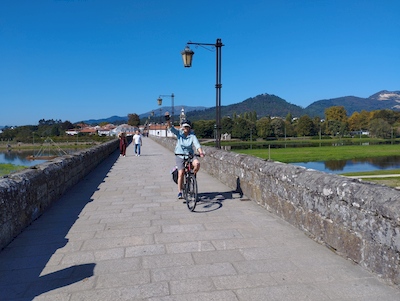
Entrance to the town was photogenic in the extreme - we rode over the Lima River on the ancient stone bridge from which the town gets its name. The bridge was originally built by the Romans in the first century AD, making it about 1900 years old. Although modifications were made to the bridge in 1370 (and several times since then), much of the original Roman construction remains. And it is still standing and in everyday use, a testament to the supreme skill of the Roman builders all those years ago. The old bridge is only for pedestrians and cyclists - vehicles cross the river via a much newer bridge a few hundred metres downriver. We liked Ponte de Lima so much that we decided to take (another) rest day and stay in the town for two nights. This is supposed to be a holiday, after all ...
[Thursday 9 October: Ponte de Lima] A relaxing day walking round Ponte de Lima. We visited the International Festival of Gardens just outside town, an exquisite show of twelve mini-gardens created by different sets of landscapers from different countries. This garden show has been held every year since 2005 (except in 2020), and is also a competition - all visitors can vote for the garden they consider to be the best. I voted for the French garden (which showcased harmony between people and nature), while Karen voted for that of the Japanese. The show ends on 31 October 2025, so we'll check back after that to see which garden was declared the best. In truth, all twelve were so good that any one of them would be a worthy winner.
[Friday 10 October: Barcelos] We wanted to spend two days in Barcelos, but we were running out of time and had to plan carefully. That meant we could not take a leisurely ride to Barcelos from Ponte de Lima but had to make it in one day. The cycling distance was over 40 kilometres - a liitle more than we had been doing per day. So we got going early and were on the riverside path out of Ponte de Lima by 8:20 am. The first third of the ride was fantastic, flat and with no traffic via the EcoVia path. After our first (rather dismal) coffee stop in the small village of Corellã, we hit narrow country lanes through cultivated fields and vineyards. Very pretty, but also very steep in places. Lung-bursting bouts of climbing were mixed with water breaks and short sections of flat terrain. Several cobbled or stony roads slowed us down even further.
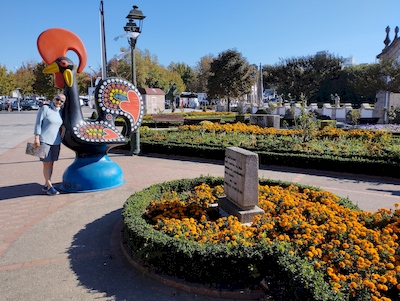
Eventually we came out in the village of Balugães. A restaurant with no character (and no customers either) appeared to be our only option for a break, until I zoomed in on Google Maps and spotted a padaria pinned a few hundred metres further. We zipped down there and enjoyed fantastic coffee and a pizza slice each at Padaria Senhora da Abadia. Two charming ladies served us, both trying (unsuccessfully) to stifle their laughter at my attempt to order in Portuguese. But I think they appreciated the effort.
The last third of the day was a nerve-wracking ride down a busy road into Barcelos. It was downhill for most of the way so it was very fast, but there was a lot of traffic, the road was narrow and vehicles were skimming past us with millimetres to spare. A lot of the time there were stone walls right next to the road, so if we'd been knocked off our bikes it would have been nasty. We made it into Barcelos, knees shaking and drenched with perspiration, to be faced with hectic mid-afternoon traffic on old city streets not designed for modern vehicles. A few nervy intersections and traffic circles later we found our way into old town. Here, at least, the streets were quiet, in the sense that there were very few cars. But loads of tourists were strolling round, window-shopping and taking photographs. We whizzed through them with a lot of swerving and braking, and eventually came to the old stone bridge over the Cávado River. Just across the river, commanding a fine view of old town and the bridge, was Top'Otel; and it proved to be a top place to stay too.
[Saturday 11 October: Barcelos] No cycling (again) ... taking another rest day in Barcelos turned out to be a great decision. Barcelos was just as charming as Ponte de Lima had been, merely slightly bigger. We had a fantastic hotel room, old town was just a stone's throw away over the bridge and the weather was perfect. In fact, it was so hot I was really glad we'd done this trip in October (autumn), rather then July or August (summer).
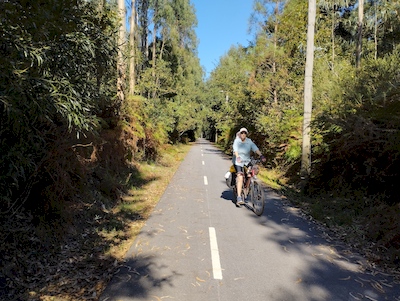
On our ramblings round Barcelos we discovered the tale behind the legend of Portugal's rooster (or cockerel). The story goes that a pilgrim journeying to Santiago in Spain was accused of stealing a silver cup from an inn where he had stayed. He proclaimed his innocence, but was nonetheless brought before the judge. The judge was about to feast on a roasted cockerel, and delayed his lunch long enough to hear the evidence and deliver his verdict: the pilgrim was found guilty and sentenced to death by hanging. The pilgrim protested that he was innocent, and told the judge that if he went through with the execution the rooster he was about to eat would rise up from the dead and sing his innocence. The judge, of course, scoffed at this and did not change his verdict. The pilgrim was taken away and hanged, and at the precise moment that the noose tightened round his neck, the rooster stood up on the judge's table and sang. Mortified, the judge hurried to the gallows, where he found the pilgrim hanging but alive - despite nothing holding up his feet, the noose was limp. This miracle was attributed to St James, patron saint of Santiago. Ever since then the rooster has been the symbol of justice and good luck in Portugal.
[Sunday 12 October: Póvoa de Varzim]
: